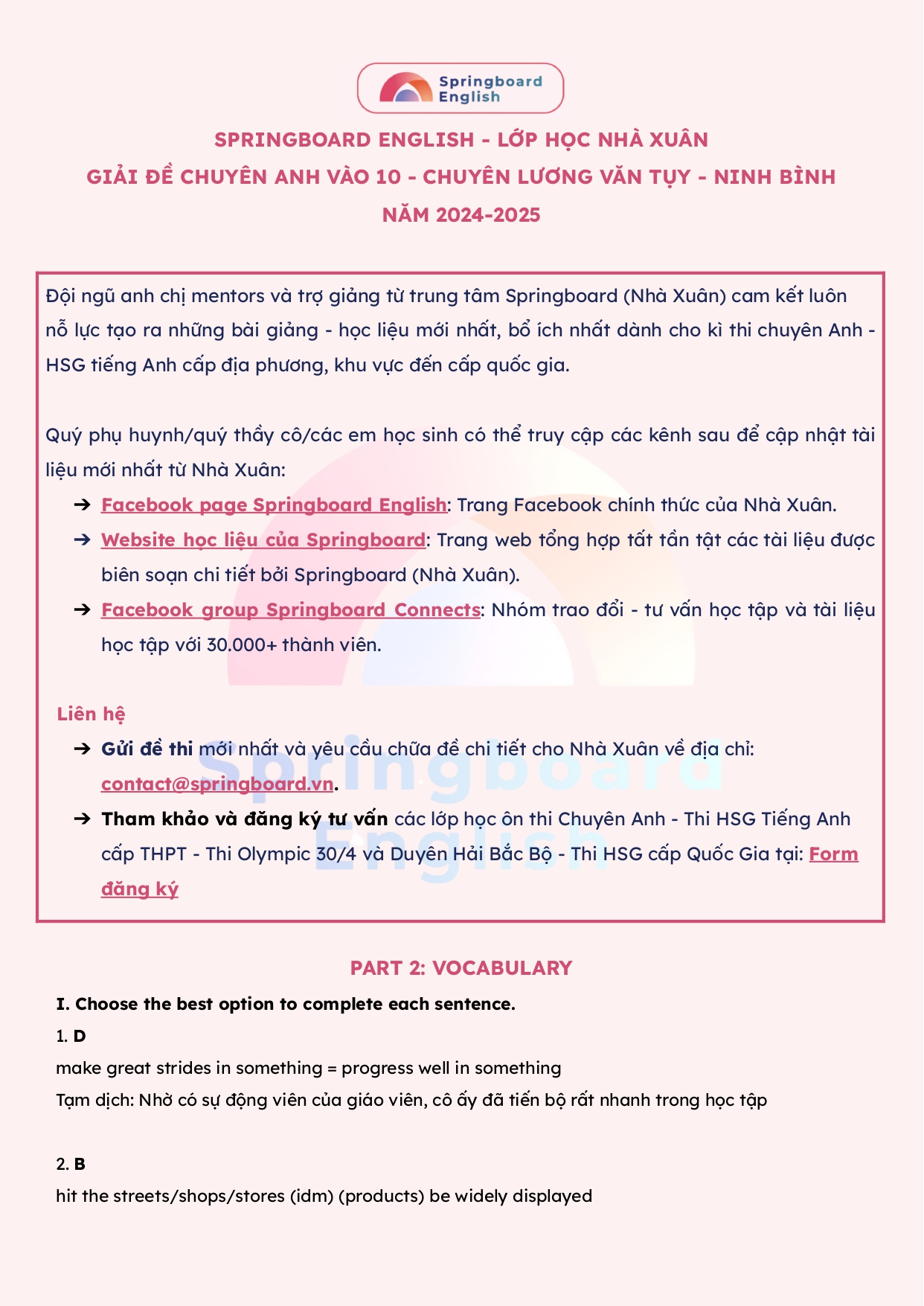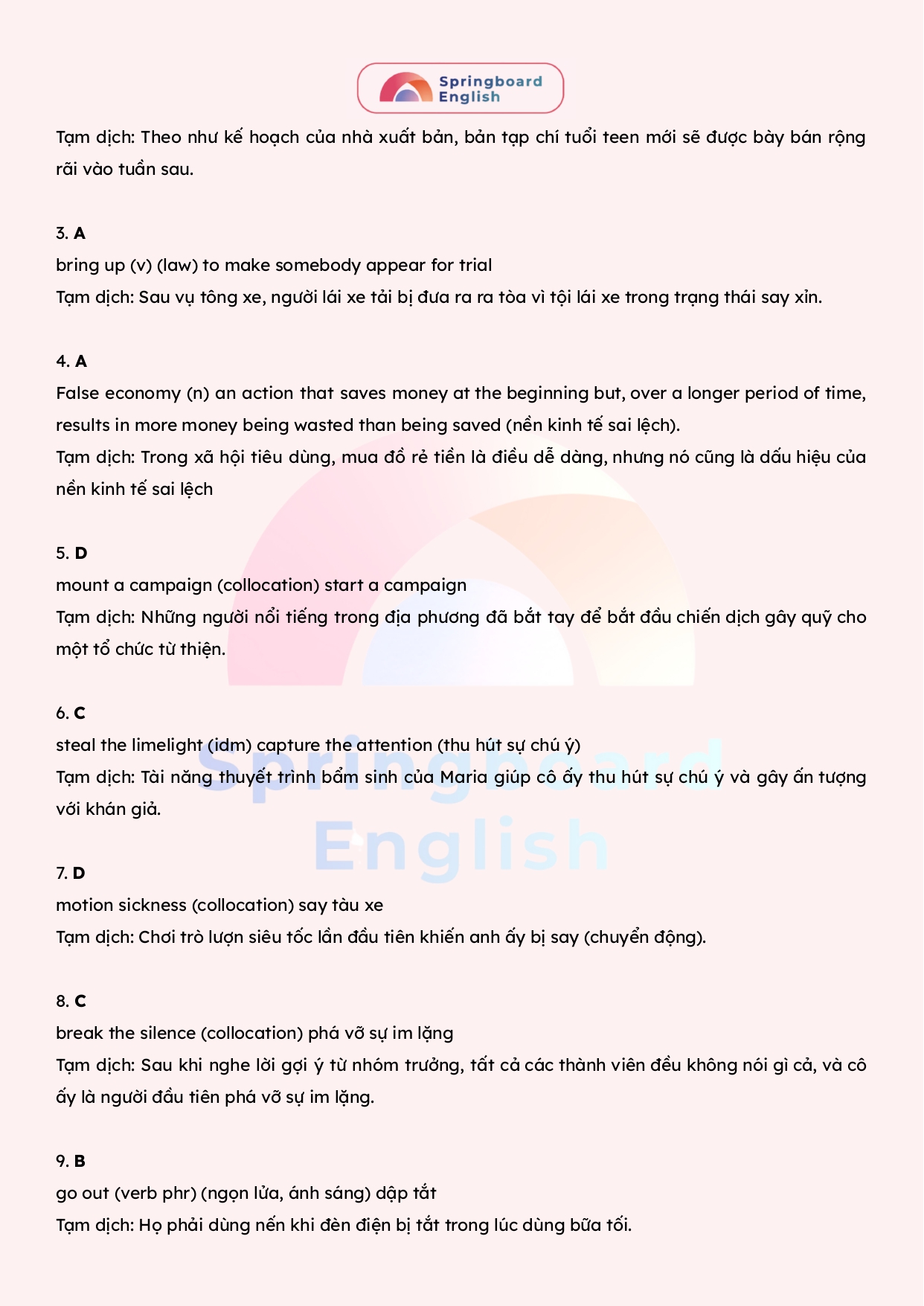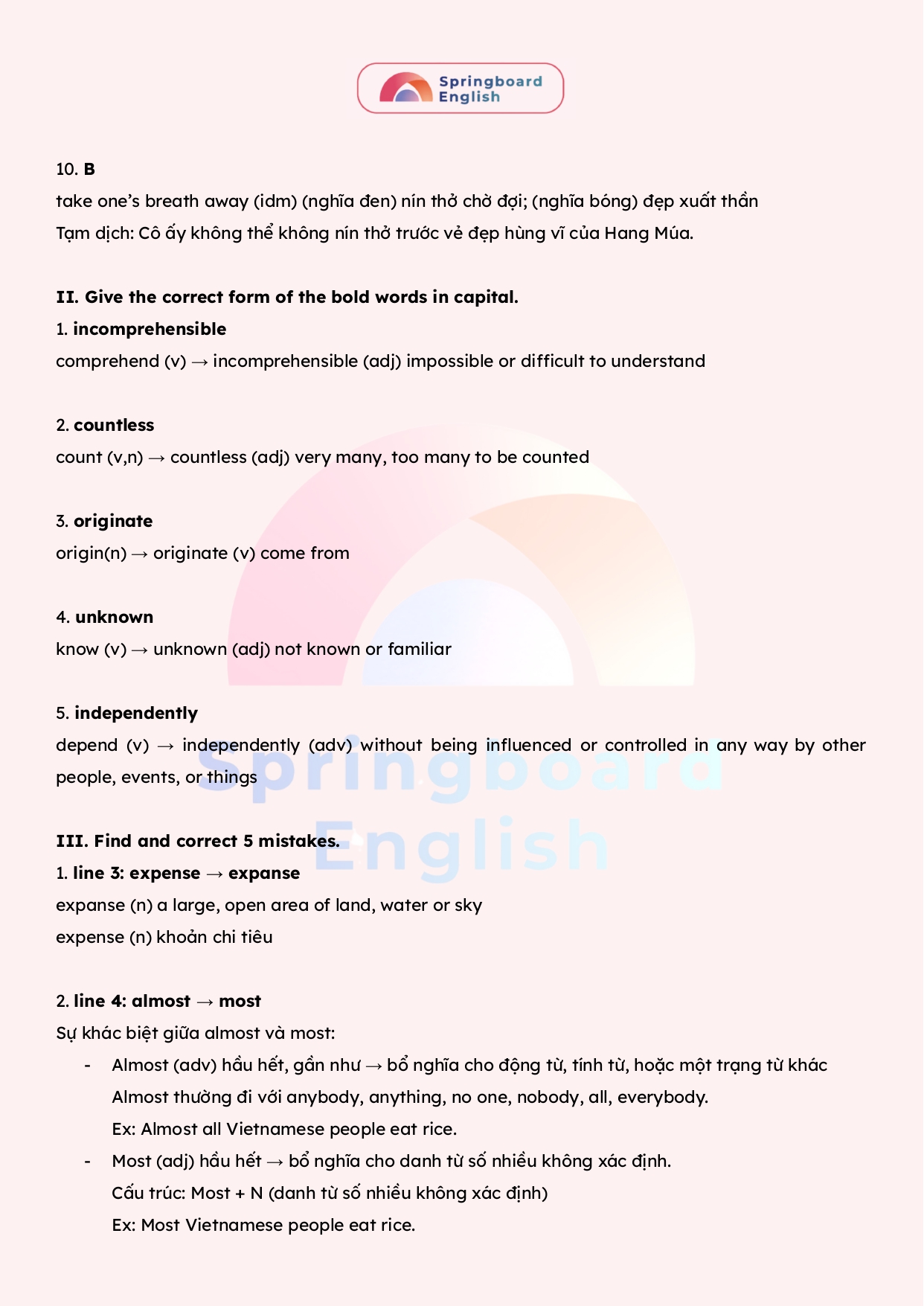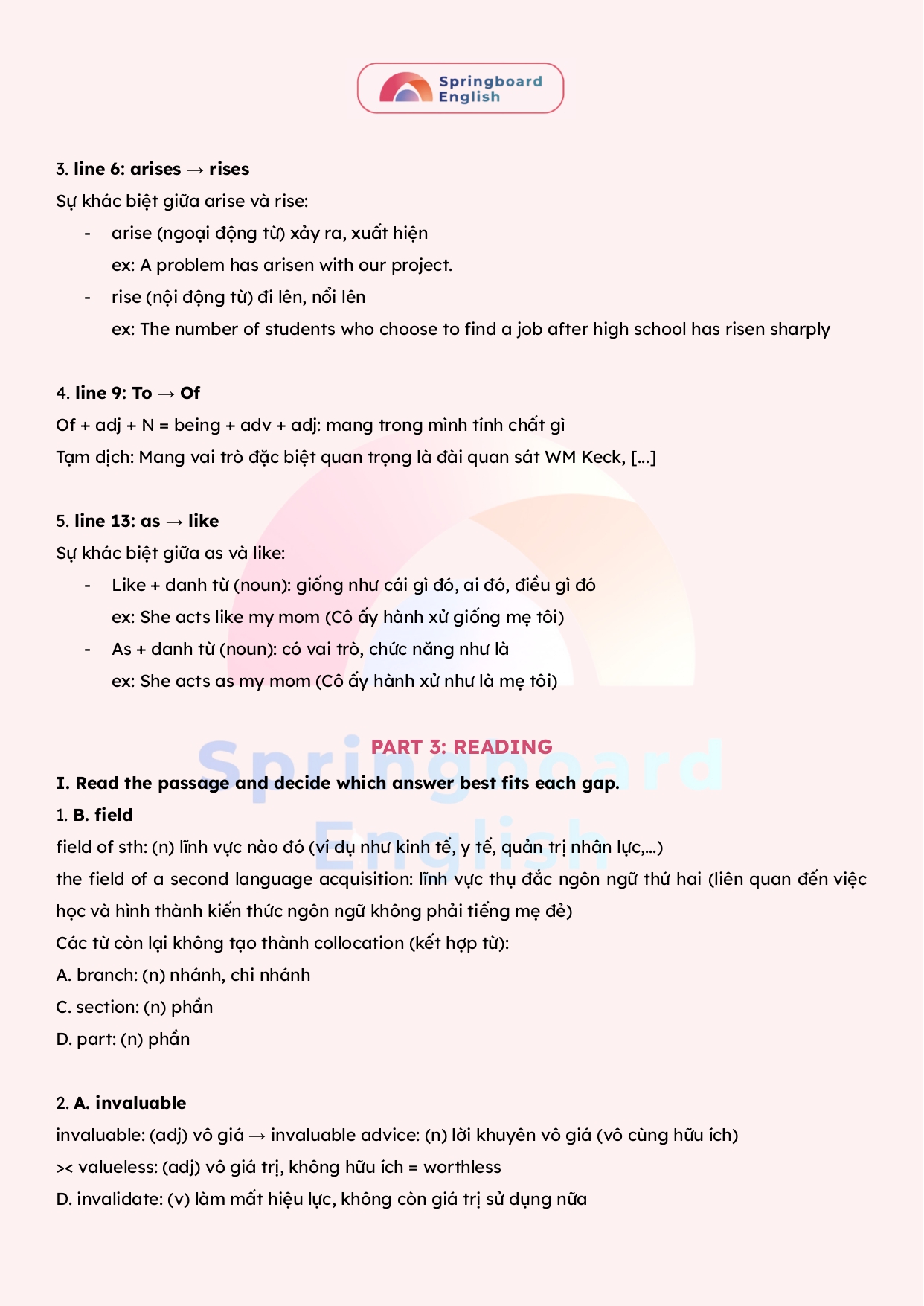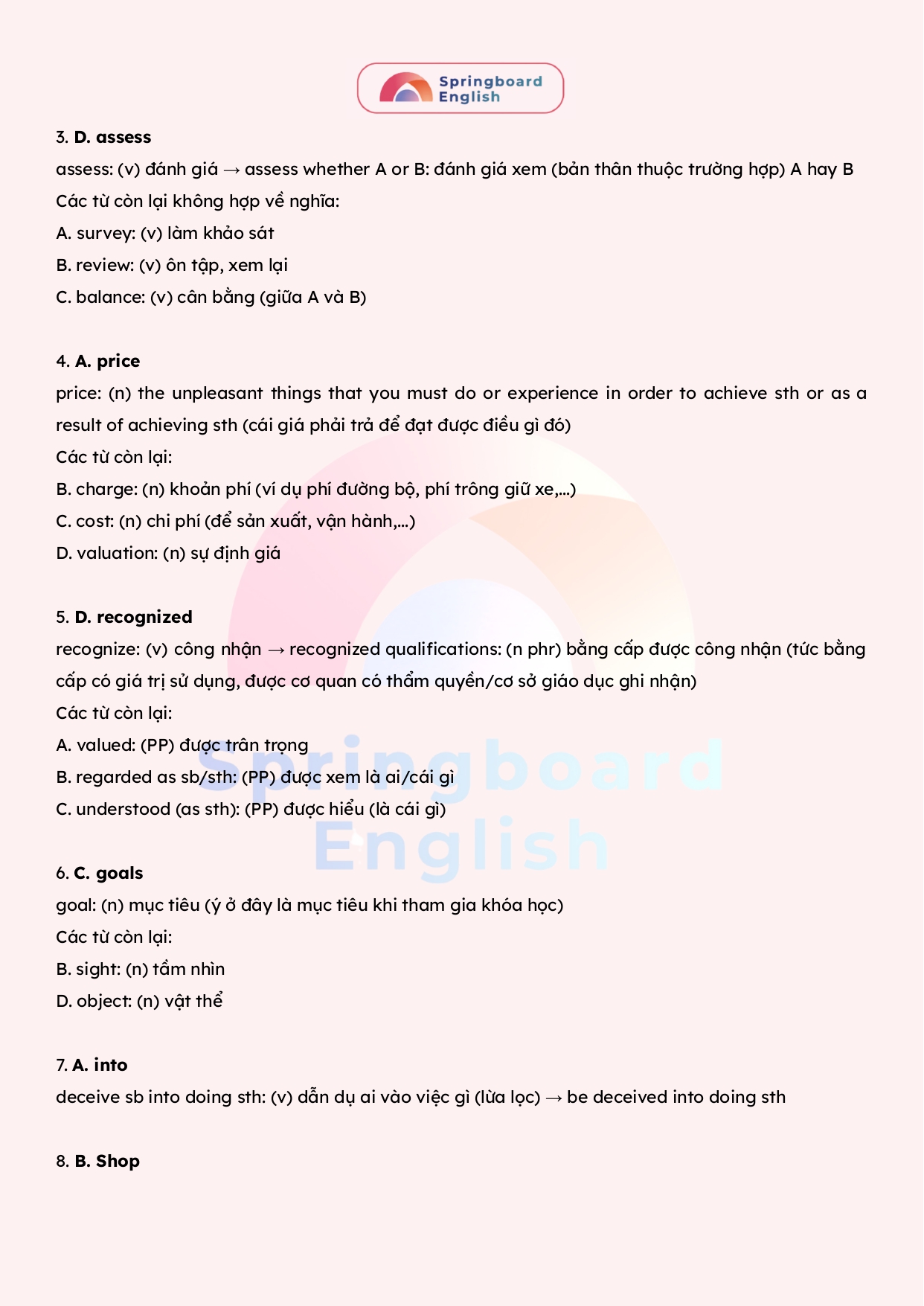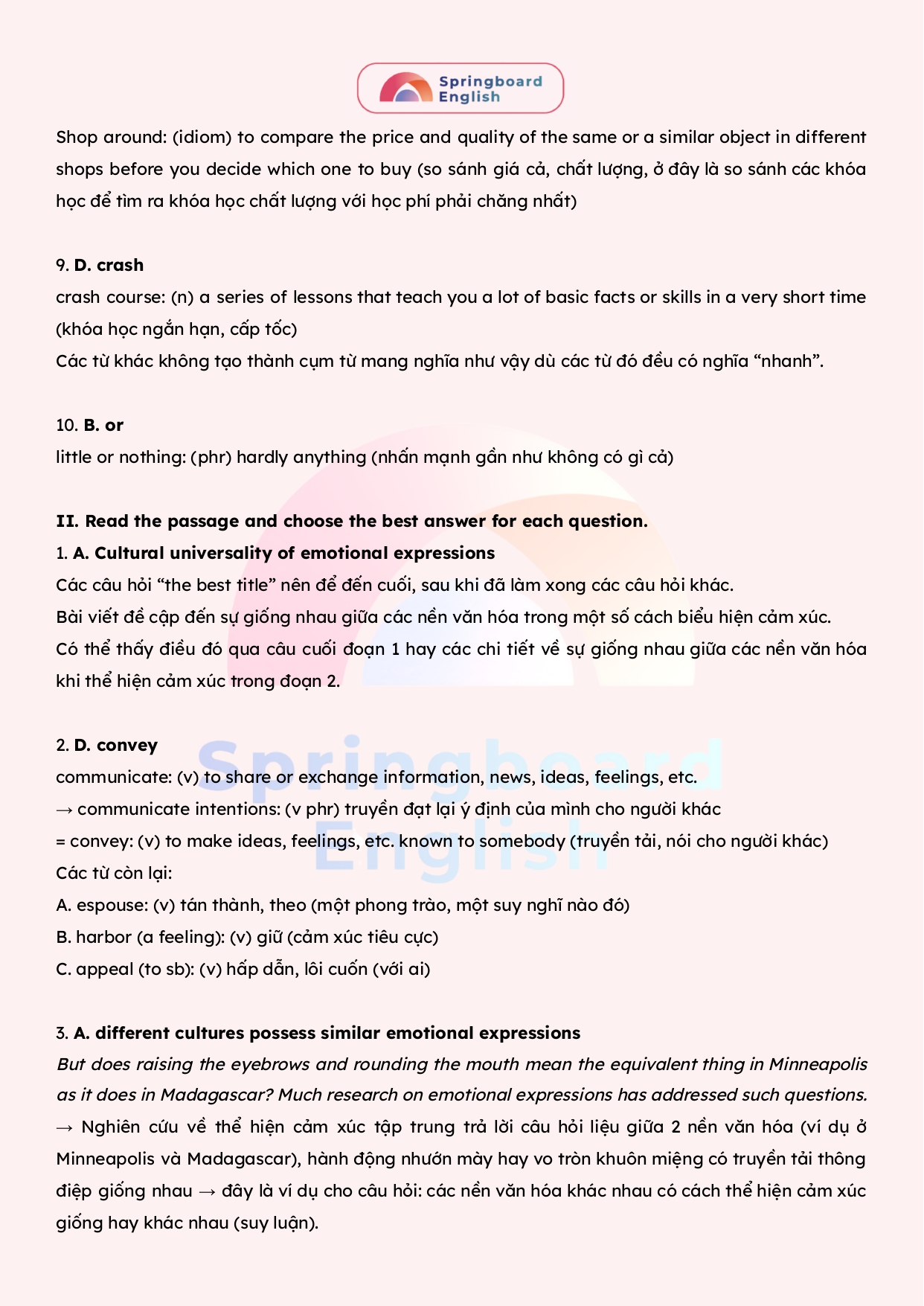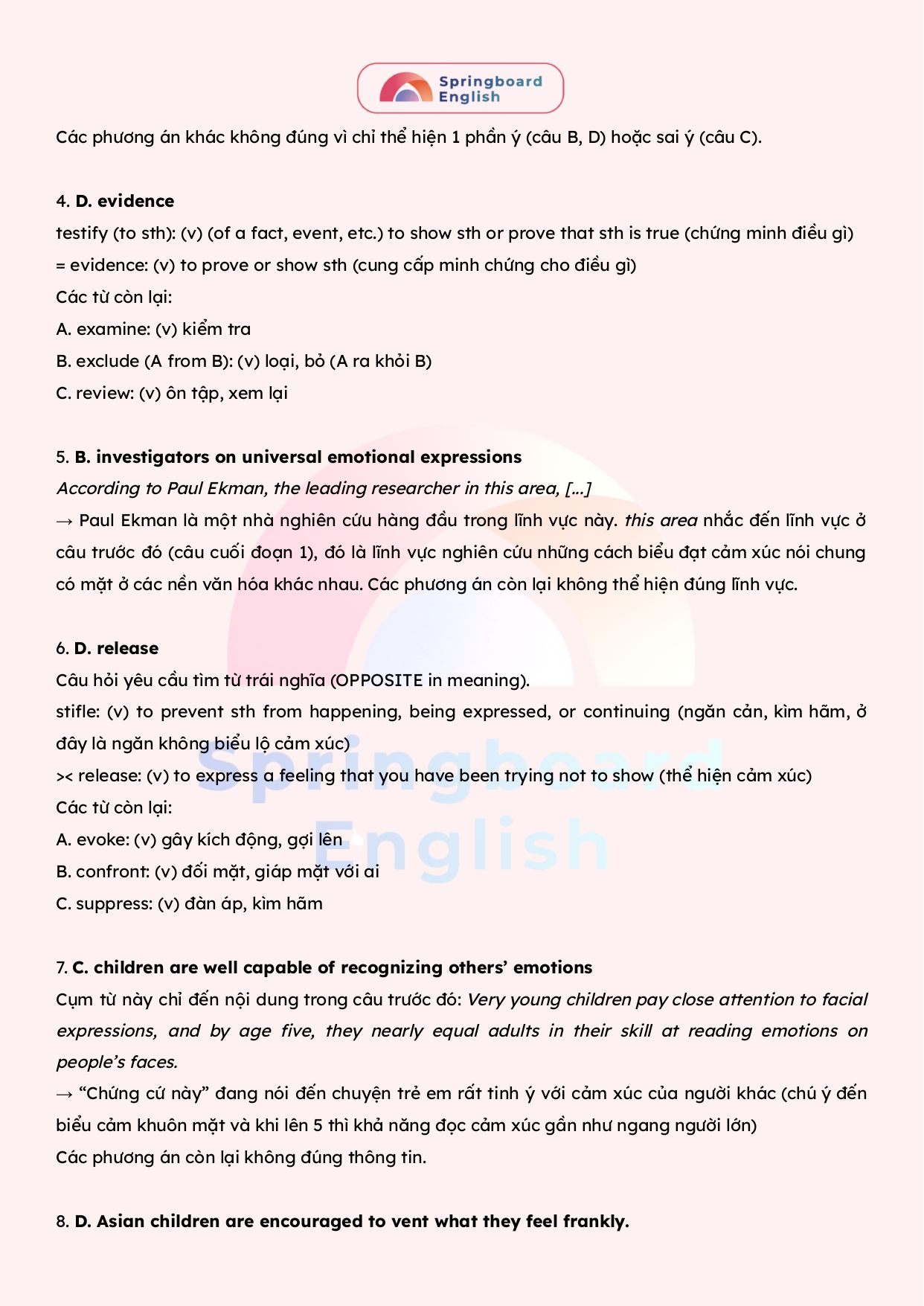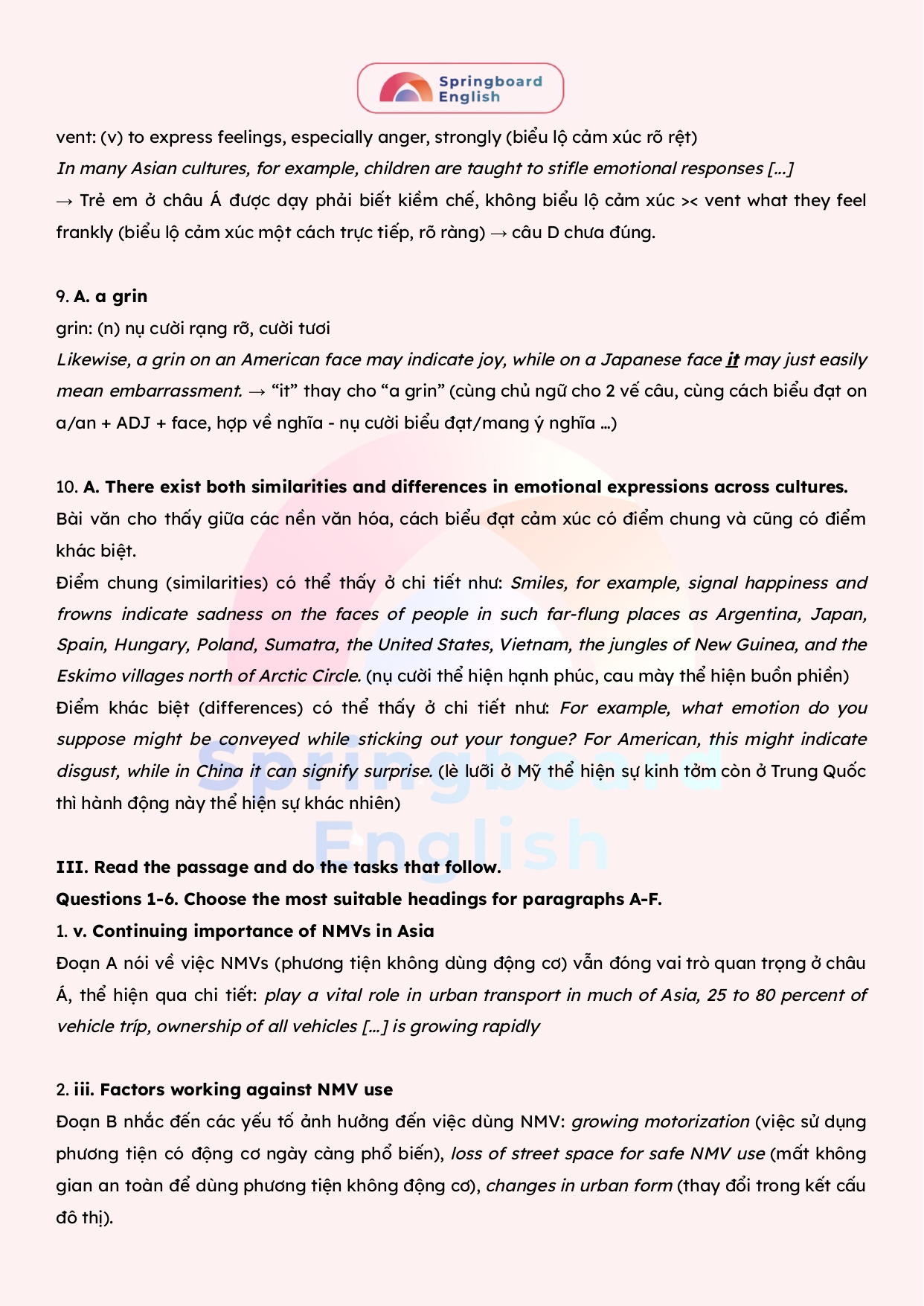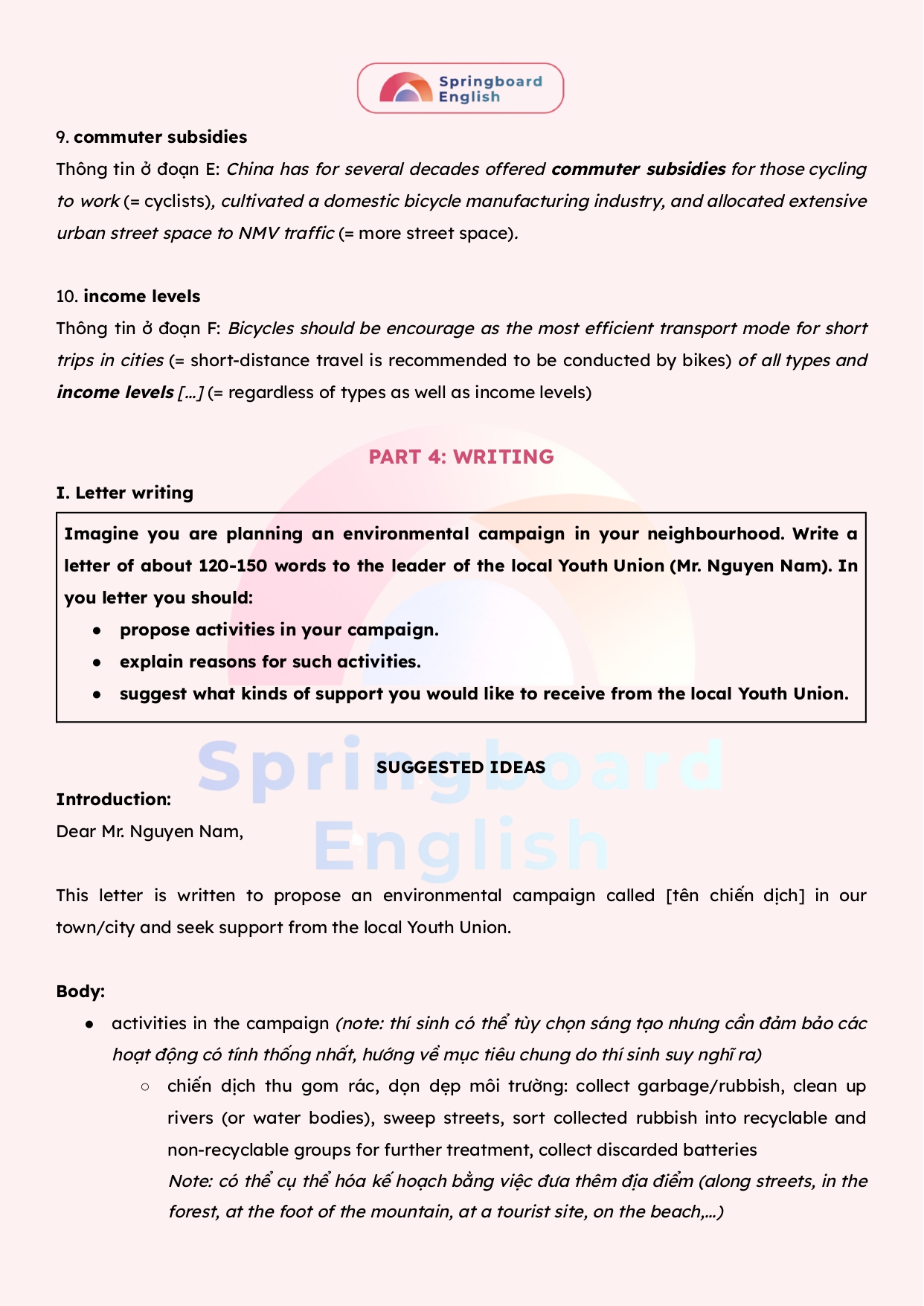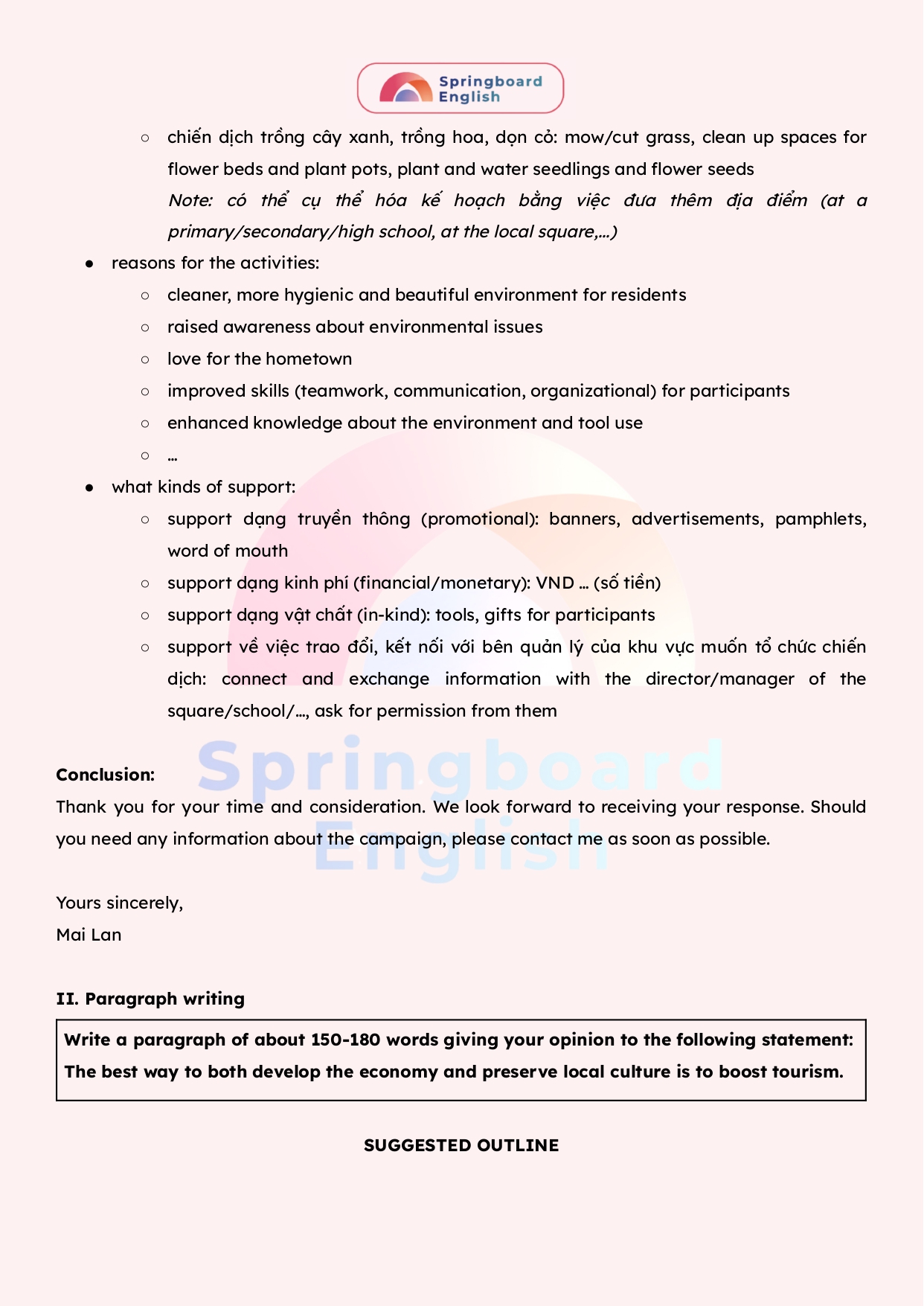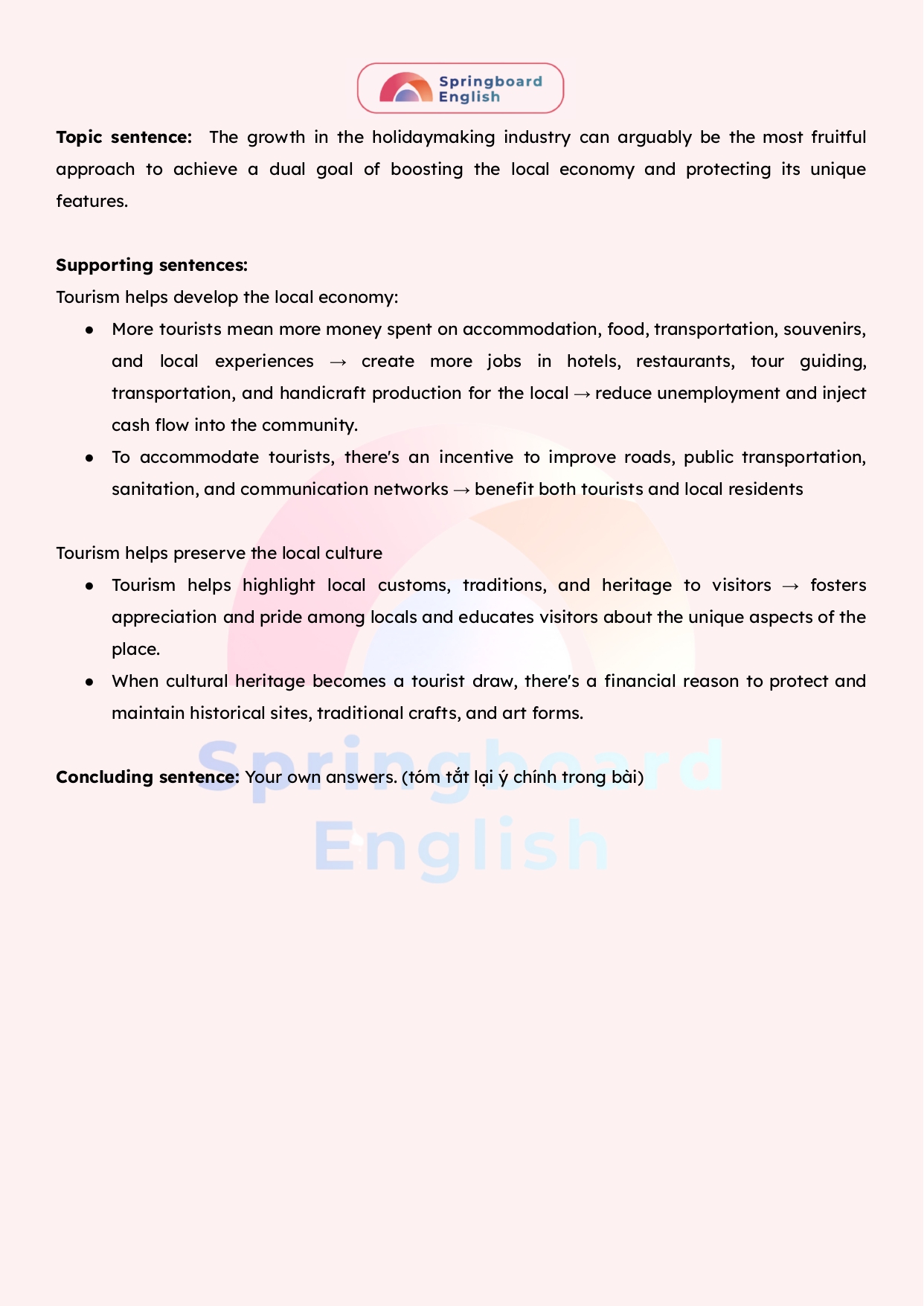Đề thi và Đáp án Chi tiết Kì thi Chuyên Anh 10, Chuyên Lương Văn Tụy - Ninh Bình năm học 2024-2025
Trong bài viết này, Đội ngũ trung tâm Springboard (Nhà Xuân) xin chia sẻ đến các quý phụ huynh, thầy cô, các em học sinh Đề thi và Đáp án có giải thích chi tiết ở kì thi chọn học sinh giỏi tỉnh Tiếng Anh lớp 12 – tỉnh Thanh Hóa năm học 2023-2024.
Phần đáp án chi tiết được giới thiệu ở bài viết này là tài liệu được biên soạn trực tiếp bởi đội ngũ chuyên môn Nhà Xuân, đồng thời là bản cập nhật mới nhất trong năm 2024.
Kéo xuống dưới cùng để xem hết đáp án có giải thích chi tiết.
Đề thi HSG Tiếng Anh lớp 12 - tỉnh Thanh Hóa năm học 2023-2024
SỞ GIÁO DỤC VÀ ĐÀO TẠO TỈNH NINH BÌNH
(Đề thi có 04 phần, 11 trang)
KỲ THI TUYỂN SINH LỚP 10 THPT NĂM HỌC 2024 – 2025
Bài thi môn chuyên: TIẾNG ANH Ngày thi: 03/6/2024
Thời gian làm bài: 150 phút (không kể thời gian phát đề)
(Thí sinh làm bài trực tiếp trên đề thi này. Thí sinh phải ghi đúng thứ tự đáp án vào ô được đánh số tương ứng)
PART 1: LISTENING (2.0 points) HƯỚNG DẪN PHẦN THI NGHE HIỂU:
Phần thi nghe hiểu dài 21 phút 03 giây.
Phần thi nghe hiểu gồm 3 bài, 20 câu hỏi. Mỗi bài nghe, thí sinh được nghe 2 lần liên tiếp.
Hướng dẫn làm bài chi tiết cho thí sinh bằng tiếng Anh đã có trong từng bài
I. You will hear people talking in five different situations and choose the best answers. Write your answers A, B, C or D in the corresponding numbered boxes. (0.5 point)
Question 1: You hear a phone-in program on the radio. Why has the man phoned?
to complain about the traffic scheme
to express his support for the traffic scheme
to question the aims of the traffic scheme
to suggest alternatives to the traffic scheme
Question 2: What should students take on the school trip?
Drink, fruit, and some change
Drink, fruit and colored pencils
Fruit, some change and colored pencils
Fruit and colored pencils
Question 3: What does the woman’s house look like now?
It has another bedroom over the garage.
It has trees in the garden.
It has a hedge in the front.
It looks the same as in the past.
Question 4: What is the next TV program about?
African animals
the Earth
satellite technology
photography
Question 5: You hear someone telling a story about a strange thing that happened in the mountain.
What point does the story prove?
how strange things can be explained simply
how easy it is to imagine things
how you can be tricked by the silence
how friendly animals are to visitors
Your answers:
1. | 2. | 3. | 4. | 5. |
II. Listen to a recorded message about an arts festival and fill in each blank with NO MORE THAN THREE WORDS AND/OR A Write your answers in the corresponding numbered boxes. (0.5 point)
Your answers:
1. | 2. | 3. | 4. | 5. |
III. Listen to Tricia Simpkins talking at a public meeting about a plan to create a nature reserve and choose the best answers to the following questions. Write your answers A, B, C or D in the corresponding numbered boxes. (1.0 point)
Question 1: How did Tricia once feel about the countryside?
She preferred it to the
She paid no attention to it.
She wanted others to experience it.
She was strongly attached to it.
Question 2: What is TRUE about Tricia’s neighborhood?
The waste ground is along the road.
Every house has a big garden.
Local residents lead a quiet life.
It is crowded with people and vehicles.
Question 3: Why did Tricia take part in a wildlife survey?
She was required to do it.
She preferred it to being at school.
She was asked to do it by her neighbors.
She was keen on local wildlife.
Question 4: What does Tricia say about the results of the survey?
They were unsatisfactory.
They were confusing.
They were unexpected.
They were disappointing.
Question 5: What did Tricia and her friends do after collecting the survey’s results?
They were informed to set a world record for these results.
They contacted another nature reserve for further information.
They gathered to see wild animals in their natural habitat.
They opened up a nature reserve in the countryside.
Question 6: Why have one hundred big old trees been cut down in Tricia’s neighborhood this year?
They have been damaged in a storm.
They have damaged local houses in a storm.
They have not served their role as ornamental trees.
They have discouraged underground equipment installation.
Question 7: What does Tricia say about the problems created by trees?
People exaggerate them.
People ignore them.
People accept them.
People underestimate them.
Question 8: According to Tricia, what is wrong with the trees the council is planting?
They fail to attract wildlife.
They are expensive to replace.
They are too small for the area.
They do not look attractive to local residents.
Question 9: What used to happen in the wasteland in Tricia’s neighborhood?
Dog owners used to go there.
People used to leave rubbish there.
Children used to play there.
There used to be a few little trees.
Question 10: What is Tricia’s suggestion for the new nature reserve?
allowing the planting of trees
protecting it from visitors
letting it go wild
preventing the loss of trees
Your answers:
1. | 2. | 3. | 4. | 5. |
6. | 7. | 8. | 9. | 10. |
PART 2: VOCABULARY (2.0 points)
I. Choose the best option to complete each Write your answers A, B, C or D in the corresponding numbered boxes. (1.0 point)
Question 1: Thanks to her teacher’s encouragement, she has made great in her study.
A. impacts B. acquisitions C. contributions D. strides
Question 2: According to the scheme of the publishing house, the new teenager magazine next week.
A. hits the decks
B. hits the streets
C. hits the spots
D. hits the buffers
Question 3: After the crash, the truck driver was on a charge of drunken driving.
A. brought up B. brought out C. brought about D. brought back
Question 4: In a consumer society, it is easier to purchase inexpensive items; nonetheless, buying a cheap thing may be a/an economy.
A. false B. artificial C. fake D. unreal
Question 5: The local celebrities joined hands to a fund-raising campaign for charity.
aim B. call C. pose D. mount
Question 6: Maria’s natural talent for public speaking allowed her to steal the and win over the audience.
A. flashlight B. greenlight limelight D. headlight
Question 7: Going on a roller coaster ride for the first time made him experience motion .
A. illness weakness C. tiredness D. sickness
Question 8: After the leader’s suggestions, all members said nothing, and she was the first one to
the silence in the discussion.
A. stop drop C. break D. pause
Question 9: They had to use candles when the light suddenly during the dinner.
A. switched off B. went out cut off D. put out
Question 10: She couldn’t help but her breath away as she witnessed the spectacular view from the top of Mua Cave.
A. bring take C. give D. get
Your answers:
1. | 2. | 3. | 4. | 5. |
6. | 7. | 8. | 9. | 10. |
II. Give the correct form of the bold words in capital to complete the following Write your answers in the corresponding numbered boxes. (0.5 point)
Until the twentieth century most scientists argued that dream was nothing but a random jumble of completely (1. COMPREHEND) images remaining from the sensory accumulation of our daily lives. Since the idea that dreams are meaningful in their own way became popular, psychologists have proposed (2. COUNT) theories to explain the logic of dreams.
The bewildering nature of this logic reflects the primary source of the dreams outside the tidy confines of the conscious mind. A dream can be a response to events in the outside world, or it can (3. ORIGIN) within, expressing aspects of the dreamer’s deep-seated feelings; it can fulfil desires or highlight unresolved emotions in the dreamer’s life. Not unexpectedly, the contradictions implicit in these complex processes are reflected in the syntax of dreams. The language of dreams can warp time, bringing together historical and contemporary figures. It can mix the familiar with the (4. KNOW) , and make fantastic transformations by its own band of magic. Scenes in dreams merge mysteriously into one another, as in certain movies. People or animals may fly or inanimate things may move (5. DEPEND) and talk. It is out of such complex and contrary happenings that the meanings of dreams have to be teased out.
Your answers:
1. | 2. | 3. | 4. | 5. |
III. There are 5 mistakes in the following FIND and CORRECT them. Write your answers in the boxes. One example has been done for you. (0.5 point)
For anyone with a fascination for the study of the night sky, Hawaii is one of the best places in the world to get a clear scenery of the stars and planets. This is because of the island’s geographical setting. Situated in the middle of a large expense of the ocean, Hawaii is much less affected by light pollution than almost other parts of the world.
An unmissable spot in Hawaii is the top of the dormant volcano known as Mauna Kea, which arises to a height of 4205 meters. It is one of the best places in the world to get uninterrupted views of the night sky and therefore is the location for more than a dozen of the world’s finest telescopes.
To special significance is the WM Keck Observatory, where there are a pair of extremely large and powerful telescopes. In recent years, these telescopes have been responsible for the discovery of around forty new planets beyond our solar system. By proving the existence of these planets, astronomers have increased the probability that one day another inhabited planet as our own will be found.
Your answers:
Line | Mistake | Correction |
2 | scenery | view |
|
|
|
|
|
|
|
|
|
|
|
|
|
|
|
PART 3: READING (3.0 points)
I. Read the following passage and decide which answer best fits each Write your answers A, B, C or D in the corresponding numbered boxes. (1.0 point)
A recent survey of a language learning magazine has consulted a number of experts in the (1)
of a second language acquisition. Their advice may prove (2) for those considering a language course. One suggestion is that you (3) whether you are likely to be successful at learning a language or whether you enjoy studying languages at school, for example. The major (4)
will be your own time and effort. Therefore, you must be sure that the course on offer leads to (5) qualifications. Also, be realistic in your (6) . If you don’t set achievable aims, you are more likely to give up. Do not be deceived (7) thinking that the most expensive courses are the best. (8) around to get the best possible value for money. You should also bear in mind that the faster you learn a language, the more quickly you forget it. Sandra Miller, a French teacher, tried to teach herself German by enrolling on a (9) course. Already fluent in four languages and with a sound knowledge of teaching methodology, her chances of making progress were high. Three years on she remembers very little (10) nothing. She feels her biggest mistake was not to follow up her first experience. “I should have consolidated what I’d learnt by continuing to study, even if it were by myself.”
1. A. branch | B. field | C. section | D. part |
2. A. invaluable | B. valueless | C. worthless | D. invalidate |
3. A. survey | B. review | C. balance | D. assess |
4. A. price | B. charge | C. cost | D. valuation |
5. A. valued | B. regarded | C. understood | D. recognized |
6. A. ends | B. sights | C. goals | D. objects |
7. A. into | B. about | C. by | D. in |
8. A. Nose | B. Shop | C. Push | D. Run |
9. A. rapid | B. quick | C. fast | D. crash |
10. A. and | B. or | C. nor | D. for |
Your answers:
1. | 2. | 3. | 4. | 5. |
6. | 7. | 8. | 9. | 10. |
II. Read the following passage and choose the best answer for each Write your answers A, B, C or D in the corresponding numbered boxes. (1.0 point)
You can usually distinguish when your friends are elated or furious by the looks on their faces or by their actions. This is useful because interpreting their emotional expressions helps to trigger our response. Emotions have evolved, hence humans can respond to important instances and communicate our intentions to others. But does raising the eyebrows or rounding the mouth mean the equivalent thing in Minneapolis as it does in Madagascar? Much research on emotional expressions has addressed such questions.
According to Paul Ekman, the leading researcher in this area, people articulate and substantially decipher the same “facial language”. Studies by Ekman’s group have demonstrated that humans share a set of universal emotional expressions that testify to the common biological heritage of the human species. Smiles, for example, signal happiness and frowns indicate sadness on the faces of people in such far-flung places as Argentina, Japan, Spain, Hungary, Poland, Sumatra, the United States, Vietnam, the jungles of New Guinea, and the Eskimo villages north of Artic Circle. Ekman and his colleagues claim that people everywhere can recognize at least seven basic emotions: sadness, fear, anger, disgust, contempt, happiness and surprise. There are, however, huge differences across cultures in both the context and intensity of emotional displays – the so-called display rules. In many Asian cultures, for example, children are taught to stifle emotional responses – especially negative ones – while many American children are made to express their feelings more openly. However, in all cultures, emotions usually show themselves, to some degree, in people’s behavior. From their first days of life, babies produce facial expressions that communicate their feelings.
The ability to read facial expressions develops early, too. Very young children pay close attention to facial expressions, and by age five, they nearly equal adults in their skill at reading emotions on people’s faces. This evidence all points to a biological underpinning for our abilities to express and interpret a basic set of human emotions. Moreover, as Charles Darwin pointed out over a century ago, some emotional expressions seem to appear across species boundaries. Cross-cultural psychologists tell us that certain emotional responses carry different meanings in different cultures. For example, what emotion do you suppose might be aroused by sticking out your tongue? For Americans, this might indicate disgust, while in China it can signify surprise. Likewise, a grin on an American face may indicate joy, while on a Japanese face it may just as easily mean embarrassment. Clearly, culture influences emotional expressions.
Question 1: What can be the best title for the passage?
A. Cultural universality of emotional expressions
B. Divergent emotional expressions worldwide
C. A review of research on emotional expressions
D. Human familiarization of displaying emotions
Question 2: The word “communicate” in paragraph 1 is CLOSEST in meaning to…
A. espouse B. harbor C. appeal D. convey
Question 3: Many studies on emotional expressions try to answer the question whether …
different cultures possess similar emotional expressions
eyebrow raising means the same in Minneapolis and Madagascar
raising the eyebrows has similar meaning to rounding the mouth
rounding the mouth has the same meaning in Minneapolis and Madagascar
Question 4: The phrase “testify to” in paragraph 2 is CLOSEST in meaning to …
A. examine B. exclude C. review D. evidence
Question 5: Paul Ekman is mentioned in the passage as an example of …
researchers on worldwide spoken language
investigators on universal emotional expressions
researchers mastering varied facial expression
researchers who can speak and understand many languages
Question 6: The word “stifle” in paragraph 2 is OPPOSITE in meaning to…
A. evoke B. confront C. suppress D. release
Question 7: The phrase “this evidence” in paragraph 3 refers to the fact that…
both adults and children express the same facial language
children are better than adults in the ability to interpret feelings
children are well capable of recognizing others’ emotions
humans’ ability to express emotions is biologically supported
Question 8: All of the following statements are true according to the passage EXCEPT…
Observing people’s emotional expressions is helpful to draw our response
A big cultural difference lies in how intensive emotions are expressed
Culture exerts impacts on the meanings of emotional expressions
Asian children are encouraged to vent what they feel frankly
Question 9: The word “it” in paragraph 3 refers to .
A. a grin B. an American face C. a Japanese face D. joy
Question 10: Which of the following can be inferred from the passage?
There exist both similarities and differences in emotional expressions across cultures.
It is not until a child reaches his maturity that he can interpret others’ facial emotions.
Humans’ emotional expressions have been unchanged throughout the mankind history.
There is no relationship between emotions and behaviors in several cultures.
Your answers:
1. | 2. | 3. | 4. | 5. |
6. | 7. | 8. | 9. | 10. |
III. Read the following passage and do the tasks that Write your answers in the corresponding numbered boxes. (1.0 point)
Non-motorized Vehicles in Asia
Paragraph A
Non-motorized vehicles (NMVs), which include bicycles, cycle-rickshaws, and carts, continue to play a vital role in urban transport in much of Asia. NMVs account for 25 to 80 percent of vehicle trips in many Asian cities, more than anywhere else in the world. The ownership of all vehicles, including NMVs, is growing rapidly throughout Asia as incomes increase.
Paragraph B
However, the future of NMVs in many Asian cities is threatened by growing motorization, loss of street space for safe NMV use, and changes in urban form prompted by motorization. Transport planning and investment in most of Asia has focused principally on the motorized transport sector and has often ignored the needs of non-motorized transport. Without changes in policy, NMV use may decline precipitously in the coming decade, with major negative effects on air pollution, traffic congestion, global warming, energy use, urban sprawl, and the employment and mobility of low-income people.
Paragraph C
As cities in Japan, the Netherlands, Germany, and several other European nations demonstrate, the modernization of urban transport does not require total motorization, but rather the appropriate integration of walking, NMV modes, and motorized transport. As in European and Japanese cities,
where a majority of trips are made by walking and cycling, NMVs have an important role to play in urban transport systems throughout Asia in coming decades.
Paragraph D
Transport investment and policy are the primary factors that influence NMV use and can have an effect on the pace and level of motorization. For example, Japan has witnessed major growth of bicycle use despite increased motorization, through policies providing extensive bicycle paths, bicycle parking at rail stations, and high fees for motor vehicle use. Denmark and the Netherlands have reversed the decline in bicycle use through similar policies.
Paragraph E
China has for several decades offered commuter subsidies for those cycling to work, cultivated a domestic bicycle manufacturing industry, and allocated extensive urban street space to NMV traffic. This strategy reduced the growth of public transport subsidies while meeting most mobility needs. Bicycles have largely replaced buses as the principal means of urban vehicular transport in Tianjin. Buses are generally slower for the same trips made by bicycle. Today, 50 to 80 percent of urban vehicle trips in China are by bicycle and average journey times in China’s cities appear to be comparable to those of many other more motorized Asian cities, with much more favorable consequences on the environment, petroleum dependency, transport system costs, and traffic safety.
Paragraph F
Bicycles should be encouraged as the most efficient transport mode for short trips in cities of all types and income levels, particularly for trips too long for walking and too short for express public transport services or where travel demand or economics do not permit high frequency public transport services. Bicycles are most important for personal transport, but also accommodate light goods hauling, being capable of carrying loads of 100 to 180 kg.
Paragraph G
Cycle-rickshaws are not as efficient as bicycles for personal transport, but should be encouraged as a complementary mode to motorized goods transport and as a passenger transit mode, particularly in countries where low wages and surplus labor are sustainable features of the economy. Where they are in use, they should be accepted as a useful part of the transportation system rather than as a nuisance or a barrier to transport system modernization. Even in high-income, motorised-vehicle dependent cities, there are opportunities for appropriate use of cycle rickshaws for short-distance movement of persons and goods and as the basis for small businesses providing goods and services at dispersed locations. They find greatest utility in cities where slow modes of transport are allocated road space separate from motorized traffic, in neighborhoods where the majority of people go from one place to another on foot or in central areas with slow traffic speed, in large factories and shopping districts, and areas where private automobiles are restricted.
Questions 1-6:
Choose the most suitable headings for paragraphs A – F from the list of headings below. Write the appropriate numbers (i-x) in the corresponding numbered boxes. One example is done for you.
NB: There are more headings than paragraphs so you will not use all of them. You may use any of the headings more than once.
List of headings
(i) Benefits of bicycle use: one country’s experience
(ii) Situations that best fit bicycle use
(iii) Factors working against NMV use
(iv) Disadvantages of cycle use
(v) Continuing importance of NMVs in Asia
(vi) Subsidizing public transport use in China
(vii) Appropriate use of cycle rickshaws
(viii) Use of NMVs to reduce motorization in Europe
(ix) Role of policies in promoting bicycle use
(x) Integrated approach to urban transport
Example: Paragraph G | vii |
1. Paragraph A |
|
2. Paragraph B |
|
3. Paragraph C |
|
4. Paragraph D |
|
5. Paragraph E |
|
6. Paragraph F |
|
Questions 7-10:
Complete the summary with words taken from the passage. Write NO MORE THAN TWO WORDS for each answer in the numbered boxes.
The employment of NMVs is overlooked in many Asian countries where (7) ______ and money
allocation mostly center on the motorized. Japan, Denmark and the Netherlands serve as striking
illustrations for the fact that (8) ______ concerning the provision of paths, parking and fee charging
of motorized transport can bring about the increase in the use of bikes. In China, the support is in the
form of (9) ______ for cyclists, the development of bicycle manufacturing industry and more street
space in cities. Short-distance travel is recommended to be conducted by bikes regardless of cities’
types as well as (10) ______. Cycle-rickshaws should also be encouraged as an efficient means of
transport in both high- and low-income cities.
Your answers:
7. | 8. | 9. | 10. |
PART 4: WRITING (2.0 points)
I. Letter writing. (0.8 point)
Imagine you are planning an environmental campaign in your neighborhood. Write a letter of about 120 – 150 words to the leader of the local Youth Union (Mr. Nguyen Nam). In your letter you should:
+ propose activities in your campaign.
+ explain reasons for such activities.
+ suggest what kinds of support you would like to receive from the local Youth Union.
Dear Mr. Nguyen Nam,
Yours sincerely, Mai Lan
II. Paragraph writing. (1.2 points)
Write a paragraph of about 150 – 180 words giving your opinion to the following statement:
The best way to both develop the economy and preserve local culture is to boost tourism.
— THE END —
File PDF - Đề thi Chuyên Anh 10, Chuyên Lương Văn Tụy - Ninh Bình 2024-2025
File PDF đề thi
Cảm ơn quý phụ huynh, thầy cô, và các em học sinh đã tham khảo tài liệu được biên soạn bởi Nhà Xuân.
Với nỗ lực để luôn tạo ra những bài giảng – học liệu hay nhất dành cho kì thi chuyên Anh – HSG tiếng Anh cấp tỉnh/thành phố đến cấp Quốc Gia, đội ngũ mentors trung tâm Springboard (Nhà Xuân) luôn biên soạn những tài liệu mới nhất với giải thích tận tâm – chi tiết.
Quý phụ huynh/ quý thầy cô/các em học sinh có thể truy cập các kênh sau để cập nhật tài liệu mới nhất từ Nhà Xuân:
- Facebook page Springboard English: Trang Facebook chính thức của Nhà Xuân
- Facebook group Springboard Connects: Nhóm trao đổi – tư vấn học tập, và tài liệu học tập với 30.000+ thành viên
- Website học liệu – springboard.vn :Trang web tổng hợp tất tần tật các tài liệu được biên soạn chi tiết bởi Springboard (Nhà Xuân).
Liên hệ:
- Gửi đề thi mới nhất cho Nhà Xuân về địa chỉ: contact@springboard.vn
- Tham khảo và đăng ký tư vấn các lớp học ôn thi Chuyên Anh – Thi HSG Tiếng Anh cấp THPT – Thi Olympic 30/4 và Duyên Hải Bắc Bộ – Thi HSG cấp Quốc Gia tại: Form đăng ký tư vấn.
Thân ái,
Đội ngũ trung tâm Springboard (Nhà Xuân)



